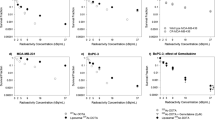Abstract
Monoclonal antibodies specific to tumor cells may be a useful tool for the diagnosis and treatment of carcinomas. In this study, YPC3 mAb, a specific monoclonal antibody against the human pancreatic carcinoma cell line Capan-2, was labeled directly with99mTc after being pretreated with 2-mercaptoethanol. The radiolabeling efficiency was found to be high (88%–95%) and the immunoreactivity retained, as assessed by immunohistochemistry and enzyme-linked immunosorbent assay. The biodistribution of99mTc-YPC3 mAb in nude mice bearing Capan-2 pancreatic carcinoma xenografts was studied and compared with that of labeled mouse immunoglobulin G(99mTc-nmIgG). The xenograft uptake values per gram of tissue 6 h and 24 h after injection of99mTc-YPC3 mAb were found to be, respectively, 4.72% ID/g and 8.42%ID/g, and the tumor/blood ratios 1.16 and 2.24. At 6 h and 24 h after injection of99mTc-nmIgG, the uptakes were 2.89%ID/g and 1.80%ID/g, and the tumor/blood ratios 0.84 and 1.02 respectively. External imaging by single-proton emission computed tomography, 24 h after injection of99mTc-YPC3 mAb, revealed clear scintigraphic visualization of Capan-2 xenografts, whereas injection of99mTc-nmIgG did not. This study suggests that99mTc labeling of monoclonal antibody YPC3 might be of practical value in localization diagnosis of human pancreatic carcinoma.
Similar content being viewed by others
Abbreviations
- nmIgG:
-
normal mouse immunoglobulin G
- T/NT:
-
radioactive ratio of tumor/non-tumor tissue
- %ID/g:
-
percentage of injected dose per gram of tissue
References
Alauddin MM, Khawli LA, Epstein AL (1992) An improved method of direct labeling monoclonal antibodies with99mTc. Nucl Med Biol 19:445–454
Brown BA, Dearbon CB, Drozynski CA, Sands H (1990). Pharmacokinetics of99mTc-metallothionein-B72.3 and its F (ab')2 fragment. Cancer Res [Suppl] 50:835s-839s
Casper ES (1993) Pancreatic cancer: how can we progress? Eur J Cancer 29A:171–172
Childs RL, Hnatowich DJ (1985) Optimum conditions for labeling of DTPA-coupled antibodies with technetium-99m. J Nucl Med 26:293–299
Frytak S, Creagan ET, Brown ML (1991) A technetium-labeled monoclonal antibody for imaging metastatic melanoma. Am J Clin Oncol 14:156–161
Goldenberg DM, Larson SM (1992) Radioimmunodetection in cancer identification. J Nucl Med 33:803–814
Goldrosen MH, Loftus R, Lioyd FJ, Biddle W, Paolini NJ, Holyoke ED, Foon KA (1988) Localization of monoclonal antibody in a novel nude mouse model of pancreatic cancer. Proc Am Assoc Cancer Res 29: A 1668
Gudjonsson B (1987) Cancer of the pancreas: 50 years of surgery. Cancer 60:2284–2303
Hertel A, Baum RP, Lorenz M (1990) Immunoscintigrphy using a99mTc-labeled monoclonal anti-CEA antibody in follow-up of colorectal cancer and others producing CEA. Br J Cancer 62 [Supp. 10]:34–36
Hnatowich DJ (1990) Recent developments in the radiolabeling of antibodies. Semin Nucl Med 20:80–91
Jewkes A, Macdonald F, Allum WH, Downing H (1988) CEA expression and radioimmunodetection of pancreatic tumors and cholangiocarcinoma. Br J Cancer 58:530
Ji JF, Dong ZW, Zhang YM (1992) Radioimmunoimaging of gastric cancer with131I-labeled monoclonal antibodies. Chin J Nucl Med 12:88–91
Lange MK, Martin EW (1991) Monoclonal antibodies in imaging and theraphy of colorectal cancer. World J Surg 15:617–622
Lind P, Lechner P, Eber O, Pinsky CM, Goldenberg DM (1991a) A prospective study of CEA immunoscintigraphy with a Tc-99m-labeled antibody fragment (IMMU-4 Fab') in colorectal cancer patients. J Nucl Med 32:1051
Lind P, Smola MG, Lechner P, Ratschek M, Klima G, Koltringer P, Steindorfer P, Eber O (1991b) The immunoscintigraphic use of Tc-99m-labeled monoclonal anti-CEA antibodies (BW 431/26) in patients with suspected primary, recurrent and metastatic breast cancer. Int J Cancer 47:865–869
Mather JS, Ellison D (1990) Reduction-mediated techenetium-99m labeling of monoclonal antibodies. J Nucl Med 31:692–697
Milenic DE, Yokata T, Filpula DR, Finkelman AJ, Dodd SW, Wood JF, Whitlow M, Snoy P, Schlom J (1991) Construction, binding properties, metabolism and tumor targeting at a single-chain Fv derived from the pancarcinoma monclonal antibody CC49. Cancer Res 51:6363–6371
Montz R, Klapdor R, Kremer B, Rothe B (1985) Immunszintigraphie und SPECT bei patienten mit pankreaskarzinom. Nucl Med 24:232–237
Montz RS, Klapdor R, Rothe B, Heller M (1986) Immuno-scintigraphy and radioimmunotherapy in patients with pancreatic carcinoma. Nucl Med 25:239–244
Rockoff SD, Goodenough DJ, Mcintire KR (1980) Theoretical limitation in the immunodiagnostic imaging of cancer with computed tomography and nuclear scanning. Cancer Res 40:3054–3058
Springolo E, Kew ML, Esser J, Beyers M, Conradie JD, Levin J (1989) The use of a monoclonal antibody against alpha-fetoprotein for the radioimmunodetection of hepatocellular carcinoma. Hepatology 9:116–120
Takeda Y, Miralles F, Daber N, Escribano MJ (1992) Radio-immunolocalization of the monoclonal antibody J28 in early transformation stages inN-nitrosobis (2-hydroxypropyl) amine-induced pancreatic tumors in the Syrian golden hamster. J Cancer Res Clin Oncol 118:377–385
Thakur ML, Defulvio JD (1991a) Technetium-99m-labeled monoclonal antibodies for immunoscintigraphy. Simplified preparation and evaluation. J Immunol Methods 137:217–224
Thakur ML, Defulvio JD, Richrd MD, Park CH (1991b) Technetium-99m labeled monoclonal antibodies: evaluation of reducing agents. Nucl Med Biol 18:227–233
Warshaw AL, Castillo CF (1992) Medical progress — pancreatic carcinoma. N Engl J Med 326:455–465
Worlock AJ, Zalutsky MR, Metzgar RS (1990) Radiolocalization of human pancreatic tumors in athymic mice by monclonal antibody Du-Pan1. Cancer Res 50:7246–7251
Zhan J, Wu LY, Li JX (1992) A direct method for labeling McAB with99mTc. Chin J Nucl Med 12:92–93
Zhang HD, Yuan SZ (1994) Generation and application of monoclonal antibodies to human pancreatic carcinoma and amplification of heavy chain variable doamin gene of antibody by polymerase chain reaction. (in press)
Author information
Authors and Affiliations
Rights and permissions
About this article
Cite this article
Chen, Q., Yuan, S. Radioimmunolocalization of human pancreatic carcinoma xenograft by99mTc-labeled YPC3 monoclonal antibody. J Cancer Res Clin Oncol 120, 668–671 (1994). https://doi.org/10.1007/BF01245379
Received:
Accepted:
Issue Date:
DOI: https://doi.org/10.1007/BF01245379




